Mezcal can’t really be the new scotch. Both spirits have been around for ages, and they each have their unique cultures and histories that support them. The way in which consumers are beginning to treat mezcal, however, is more like what it truly is: a world-class spirit that’s worthy of the highest esteem. And what better comparison can be made? Not only is scotch one of the most highly esteemed spirits in the world, it’s also got a lot in common with mezcal, and enthusiasts are taking note.
Among other things, scotch whisky fans are finding that many of things they love most about their peat monsters, sherry bombs, and iron drams have an equivalent in the world of agave spirits. Some of them will note the similarities in aromas and flavors, while others enjoy the adventure of diving down another rabbit-hole, and still more arrive at agave spirits and mezcal on their own paths entirely.
Whisky and Mezcal Beginnings
Tyler and I are by no means experts in the wild world of whisky, but we first began picking up on some of profile similarities between scotch and mezcal as we were initially planning the wiry skeleton of this website, several years ago. As we dove deeper into the world of mezcal, we began bringing bottles to parties, meetups, and anywhere people were gathering. One of the places we kept visiting was the home of our friends Matt and Chris. Chris had some experience with mezcal at that point, but Matt was (and still is) completely engulfed in the world of scotch.
We started bringing bottles of Nuestra Soledad, Alipus, and Del Maguey over to their house, and Matt would usually be pouring Ardbeg, Laphroaig, or Lagavulin (among others). He was particularly interested in Islay scotch whiskies, which are produced on Islay, one of the five whisky distilling regions in Scotland whose identity is protected by law (similar to the Denomination of Origin laws that relate to mezcal). Naturally, we began pairing scotches and mezcals in an ad-hoc fashion, and soon found that there were many that actually paired pretty well together.
Collectors and Batch Picks
Fast forward to Spring 2020, and Matt is still (sometimes literally) swimming in Islay scotch, but he’s also converted a portion of his bar space to mezcal and other agave spirits. Like many, he’s grown into having an appreciation of mezcal, while still cherishing his salty, peated scotches. This scotch-to-mezcal crossover is a growing trend that we’re seeing more and more online and in our agave spirits groups in the US.
The mezcal retail market, especially for the more rare, small batch mezcal releases, is beginning to reflect this as well. Consumers are clamoring to get their hands on new releases like the Black-bottle El Jolgorio mezcals and other limited batches from brands like Cinco Sentidos, Real Minero, and Mezcal Vago. There are even several after-market communities on Facebook, where some enthusiasts are selling limited edition mezcal releases. Some are sold at reasonable, close-to-retail prices, while others are selling for three to four times the original retail value. What’s the street value of a mezcal that sits in storage for 10 years? Only time will tell.
A few aftermarket mezcal sales are hardly rocking the category, however, and they likely won’t make or break anyone’s future at this point. These aftermarket social media groups are still relatively small. This minimal aftermarket activity on social media pales in comparison to what is happening in scotch whisky, where there are investment firms whose sole purpose is to purchase these liquid assets to allow them to appreciate over time. One such example is the Platinum Whisky Investment Fund, which raised approximately USD $12 million from 50 private investors in 2014. According to Forbes, this company currently holds a portfolio of around 9,000 bottles of rare whiskies and an independent valuation of its portfolio shows it appreciated at an annual rate of 17% between 2014 and 2017 (Source). That’s mucho dinero. Is it only a matter of time before that type of investment lands in mezcal? It doesn’t seem likely at this point, but anything could happen.
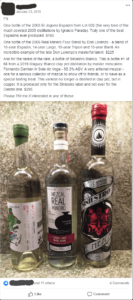
Aftermarket sale of a few different bottles on a Facebook group.
Will spirits collectors and investors ever swoop in on agave spirits like they have with scotch? It’s hard to say for certain. Tyler and I, for example, both have closets full of mezcal. But we’re not really collectors or investors. We just buy what we like. Some of our bottles are opened, some are not. Our friend William Scanlon (of Heavy Metl Imports) once told us that if you ever taste something you really like, you should buy three bottles: one for now, one for later, and one for the back of the closet. So this advice has lead to us creating a fairly massive mezcal cellar of our own. More extreme examples are out there. We’ve heard of some people with storage units full of Mezcal Vago cases from several years ago.
In addition to individual consumers collecting mezcals, many retail stores and bars are beginning to do batch picks, where they purchase the entirety of a mezcal batch for the exclusive sale at their store. The practice of barrel picks, where a store selects a private barrel for exclusive sale at their store, has been happening for ages in scotch (and some other spirits), and the mezcal community is beginning to demand the same. We first saw this with a batch of Rey Campero Espadin that was exclusively bottled and sold at Alamo City Liquor in San Antonio in late 2017. Since then, there have been lots of exclusive batches popping up, with stores like K&L Wines, Moreno’s Liquor, and The Austin Shaker doing this on a seemingly regular basis. Mezcal brands like Del Maguey have also produced exclusive batches for restaurants like Las Perlas (in Austin and LA).
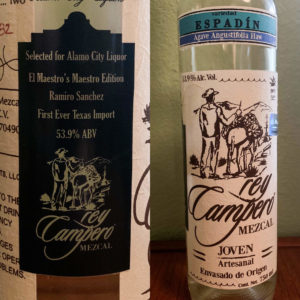
Rey Campero Batch Pick for Alamo City Liquor in San Antonio, TX.
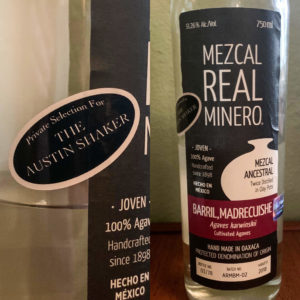
Real Minero Batch Pick for The Austin Shaker in Austin, TX.
Ilegal Smooth, Repo on Rye, and Other Mezcal/Whisky Collaborations
This growing shared interest among the scotch and mezcal communities is beginning to drive some interesting and sometimes bizarre partnerships to form cross-category. Mezcal producers and whisky producers are actively working together in some cases, to create products that pull from the traditions of each spirit to create something entirely new. While there doesn’t seem to be much data warranting the need for these cross-over spirits projects, some of them are beginning to make some waves.
One of the most recent high-profile mezcal/whisky collaboration projects comes from the masterminds at Mezcal Ilegal and Dewar’s Scotch Whisky. Their Ilegal Smooth release was created when Mezcal Ilegal sent 400 of their Anejo barrels to Scotland to be used for aging a Dewar’s blended scotch whisky.
Our friend Mike G, of the fantastic Show de Vie Podcast, recently tasted the Ilegal Smooth release as part of a newer project, Three Minute Tasting, which he launched with Leslie Nava in the summer of 2019. The format of Three Minute Tasting is entertaining, fun, and sometimes even smoother than this Ilegal/Dewar’s collaboration. And the content of the show has some teeth! They’re not afraid to publish a video featuring a spirit that they don’t like. See what they had to say about the Ilegal Smooth release from Dewar’s.
Wahaka Mezcal also created a similar exchange project with Wigle Whiskey. Wahaka got some used Wigle Whiskey barrels, and Wigle got some used Wahaka barrels. Wigle Whiskey aged a rye whiskey for a release they called Oaxacan Rye. Wahaka aged a batch of agave Espadin for 12 months in the used Wigle Whiskey barrels to create their Repo on Rye release. While rye whiskey is obviously not scotch, it’s a similar idea that drove this project to fruition.
Another interesting new project comes from Single Cask Nation, who recently released a Single Cask Nation Fidencio Añejo. According to their website, Single Cask Nation™ began as a social fellowship or membership society organized around the right to purchase rare, fine single cask whiskies under the Single Cask Nation label. More than a mere club, Single Cask Nation™ represents a unique virtual community in which members share a common affinity for the quality whiskies and other spirits of the world. Their online archives reveal a whisky-exclusive catalog, meaning this Fidencio partnership is the first or one of the first of their releases to venture into any other spirits.
Some mezcal purists and scotch purists might scoff at projects like these, which is fine. To me, these are creative releases that may sway some whisky and/or mezcal drinkers to expand their palate and try something new. They’re international collaborations that help to pull the spirits of mezcal and scotch and little closer together, to potentially peak the interest of someone new, which is pretty cool to me.
t8ke.review
The parallels between scotch and mezcal are certainly appealing, but the larger whisky/whiskey umbrella covers a lot more than just scotch. There’s bourbon, rye, Canadian, Japanese, etc…. each with their unique processes and profiles, and each potentially matching with mezcal in different ways. To help draw these spirits a little closer together, we asked our friend Jay at t8ke.review for his thoughts on the whisky-mezcal subject. As of the writing of this blog post, he’s reviewed well over 1,000 whiskies (over 500 scotches) in addition to many other spirits, including mezcal. He’s also an admin of the r/mezcal subreddit, which is another great venue for agave spirits discussion. Here’s what he had to say about his experiences with whisky/whiskey (of all kinds) and mezcal.
“Some years ago, bourbon was all I could think about. I lived in a small bubble, during a time where a lot of really great bourbon was inexpensive. It wasn’t the Pappy on CVS shelves days, but it was close. After a year or so, I noticed that a lot of bourbon tasted the same, and while I really loved those tastes, they could be repetitive and weren’t always enticing or exciting. Thankfully, there were other whiskeys out there for me to explore (other spirits couldn’t possibly exist, right?) so I looked towards Scotch. Scotch was daunting, it was a wide world of words and phrases I’d never heard, and I was hooked. No longer was a bottle likely to taste like cinnamon, vanilla, oak and clove. Maturations varied, ages were all over the map. Cask strength could be 41% ABV or 65% ABV. You could get anything finished in a cask from anything else (mostly). It was a broad experience I knew I was going to enjoy becoming an expert on.
As the years rolled by, I still loved scotch. It was incredible that I could find a scotch for every mood. Winter called to me with peated drams. My sweet tooth could always depend on a sherry matured scotch – dialed up to 11 if I wanted. There were massively fruity scotches, some dry and mineral forward. Like the world of wine, there was an expression for every flavor, or combination, of flavors at almost any price point. Some favorites became apparent early on: GlenDronach, Ledaig, Glen Scotia, Springbank and Laphroaig. Some took a little time, like the bakery overload of Ben Nevis, the luster of Independently Bottled Highland Park, or the ever watching Glenrothes. Hundreds of expressions later, I found myself just as interested in scotch as the first day I stepped into the pool. That’s what I love about Scotch.
At this point, you probably wonder where Mezcal comes in, because I’ve spent a whole lot of time rambling about whiskey. What happened? El Jolgorio Arroqueno happened. At this point, I was still a whiskey guy, but someone I knew sent me a sample of El Jolgorio Arroqueno. I had no idea what to expect. I bet it’s like tequila, I told myself. Five seconds later, I knew I was wrong.
Mezcal was completely new to me. In every way. I knew I wanted to investigate more. After some light google-fu, I felt a very familiar feeling. It was like Scotch Day #1 – a universe of expressions, producers, process variability and prices. I quickly realized one thing separated the two universes, though, and it was what ended up intriguing me most.
To this day, I’ve reviewed a hair over 500 scotches. I have notes for about 700 various expressions. At this point, I generally know what to expect from an expression – not 100%, but close. I know what to expect from a 16yr Ledaig matured in sherry casks. 12yr Ben Nevis from a hogshead is the same story. The list goes on. I realized this pretty early on, as well. This made finding things I thought I would like simple and straightforward. It was fun, but predictable. I still buy a lot of scotch because the list of what I like is long, and I generally get what I expect. The agave world is completely different to me.
Recently I did a side by side of 5 different madrecuixe (look for that to hit soon) and everyone was so wildly different from every other one. This helped me realize what I love most about Mezcal. Almost every bottle is an island. I know what to expect from bourbon, from scotch, from irish whiskey. From most gin. But never with agave. Even something “simple” like Espadin. Line up 10 Espadin agaves, and you’ll more than likely find 10 different flavor profiles, all representative of their region, producer, still type, and twenty other variables. This is magical and leaves me never knowing quite what to expect from a bottle. I wish I could afford to buy them all, because the fear of missing out on a crazy good bottle is higher in Mezcal, to me personally.
With mezcal, there is always something new. Even in the mundane there are gems. Banhez Espadin-Barril is one of my favorite bottlings. It has an insane quality to it, and it’s $30 here in Wisconsin. On the other end of the spectrum, El Jolgorio Black Bottle Pechuga is the same way. This shocking range of variability speaks to all the things I liked best about Scotch and takes it a step further.
Some days I think it’s a phase, but then another wild Papolometl bottling matured in cow hide hits my shelf, and I know I’m here for life. I used to be a Scotch drinker. Heck, I’m still a Scotch drinker, but the world of Mezcal has captured me and held my attention in ways the world of whiskey can’t even begin to touch.”
t8ke.review’s comments about the rabbit hole of complexities in both spirits really resonates. There are so many variables involved in the production of both scotch and mezcal that create seemingly endless possibilities when it comes to the final spirits we pour into our glasses. Both spirits provide the opportunity for enthusiasts to continually expand their knowledge in seemingly limitless ways.
The Scotch and Mezcal Tasting
Earlier this year, we decided to formalize a tasting we’d discussed a hundred times: Scotch + Mezcal. We’d dreamed up dozens of different scenarios for how we could pull off a tasting of this magnitude, but in the end we decided on the simplest among them. Tyler and I brought some of our favorite mezcals over to Matt and Chris’ house, where a treasure trove of various Highland, Speyside, and Islay scotches resided.
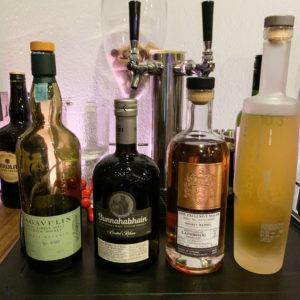
Some of the scotches sipped in the Scotch/Mezcal tasting.
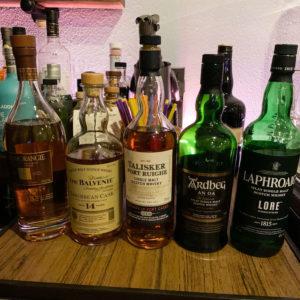
More scotches sipped in the tasting.
Our plan was simple: to sip mezcal and scotch side by side, and to discuss. The selection was somewhat limited based on 1) the mezcal we brought over that day, and 2) the scotches that they had available on their shelf. We ended up tasting a wide variety of scotches and mezcals, but these are some of the mezcal-scotch pairings that we enjoyed the most:
| Mezcal | Scotch |
| El Buho Espadin | The Balvenie 12-year Single Barrel |
| El Jolgorio Espadin (from Jose Cortes Santiago) | Glenmorangie 18-year |
| El Jope Arroqueno | Ardbeg AN OA |
| Rey Campero Espadin | Talisker Port Ruighe |
| Vago Espadin (from Aquilino Garcia) | Lagavulin Double Matured |
During the tasting (and through a few other ad-hoc mezcal-scotch pairings in the past), a few things stood out to us. Some of them were expected. Others were not.
We expected Joven (non-barrel aged) mezcals to be closer in profile to scotches, and of course we found this to be true. While a mezcal Reposado or Anejo may lineup better with a bourbon or something a little sweeter, they are indeed not good matches for scotch. Also as expected, mezcals distilled in copper more closely aligned with the profile of scotch. While I personally love clay pot distilled mezcal, it’s feel and flavor are nowhere near what we’ve found in scotch or any other spirit for that matter. Lastly, we found that agave Angustifolia (maguey Espadin, etc…) or agave Americana (maguey Arroqueno, Coyote, etc…) were a much better fit than some of the more funky agaves like Salmiana or even many of the Karwinskii agave (maguey Madrecuixe, Largo, etc…).
We also discussed some other interesting parallels. The regional spelling of whisky vs whiskey, for example, is similar to regional spellings in the maguey used to produce mezcal, like maguey Cuixe vs Cuishe, Tepextate vs Tepeztate, etc… The regional spellings are largely cultural for both spirits (and btw, we used this as our style guide for the whisky vs whiskey spelling in this blog post). We also discussed the time it takes for each of these spirits to be produced. By law, scotch only needs to be aged in wooden barrels for 3 years after distillation, but most single malts will age for at least 8-10 years. Coincidentally, maguey Espadin (agave Angustifolia), which is the most commonly used agave in mezcal, takes about 8-10 years to reach maturity, depending on the region where it’s grown. So the majority of single malt scotches and Espadin mezcals take about the same amount of time from seed-to-glencairn/copita. The majority of those 8-10 years for scotch is post-distillation, while the majority of the 8-10 years for mezcal is pre-distillation.
One of the most common similarities we discussed is perhaps the most obvious: both scotch and mezcal can be pretty smoky. Peated scotch whisky gets it’s smoky flavor from the compounds which are released by the peat fires used to dry malted barley. The characteristics of the peat as well as the length and intensity of exposure generally dictates the strength of the smoky flavor. Similarly, mezcal gets it’s smoky flavor from the wood that is used to cook the agave in an underground pit oven. The smokiness will vary by wood type, arrangement in the oven, and the overall exposure that the agave gets to the direct smoke. It’s worth noting here, that there are some who consider a smokier mezcal to be less-well-made, but that’s a topic for a different blog post entirely.
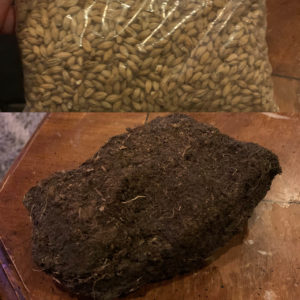
Barley and peat, which give scotch whisky it’s smokier taste.
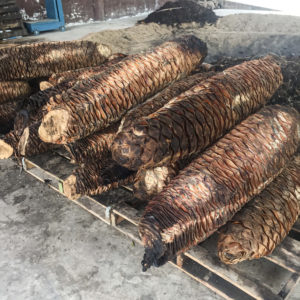
Cooked/smoked agave, which give mezcal it’s smokier taste.
So to recap, if you’re a fan of scotch and want to dip your tasting toe into the world of mezcal, look for a Joven, copper-distilled mezcal that is made with maguey Espadin (agave Angustifolia). Some brands that typically produce really solid mezcals in this category are Rey Campero, El Jolgorio, Dixeebe, and Vago (produced by Aquilino or Emigdio. Check the label).
Is Mezcal the New Scotch?
No. Mezcal is not the new scotch, but in many ways, the way that we treat mezcal is looking more and more like a world-class, high-end spirit, similar to how scotch is celebrated around the globe. Collaboration projects are bringing whisky and mezcal producers together, and there’s a growing number of scotch enthusiasts looking to Mexico as the next great frontier in artesanal spirits.
Are these collaboration projects effective? Did you or someone you know find mezcal after dabbling in other spirits like whisky? Is the heightened treatment of mezcal sustainable and good for the category? We’d love to hear your thoughts below.


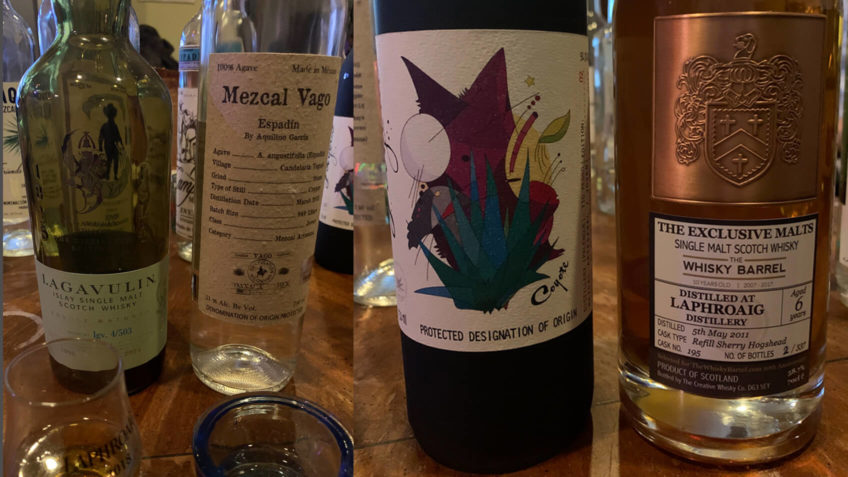



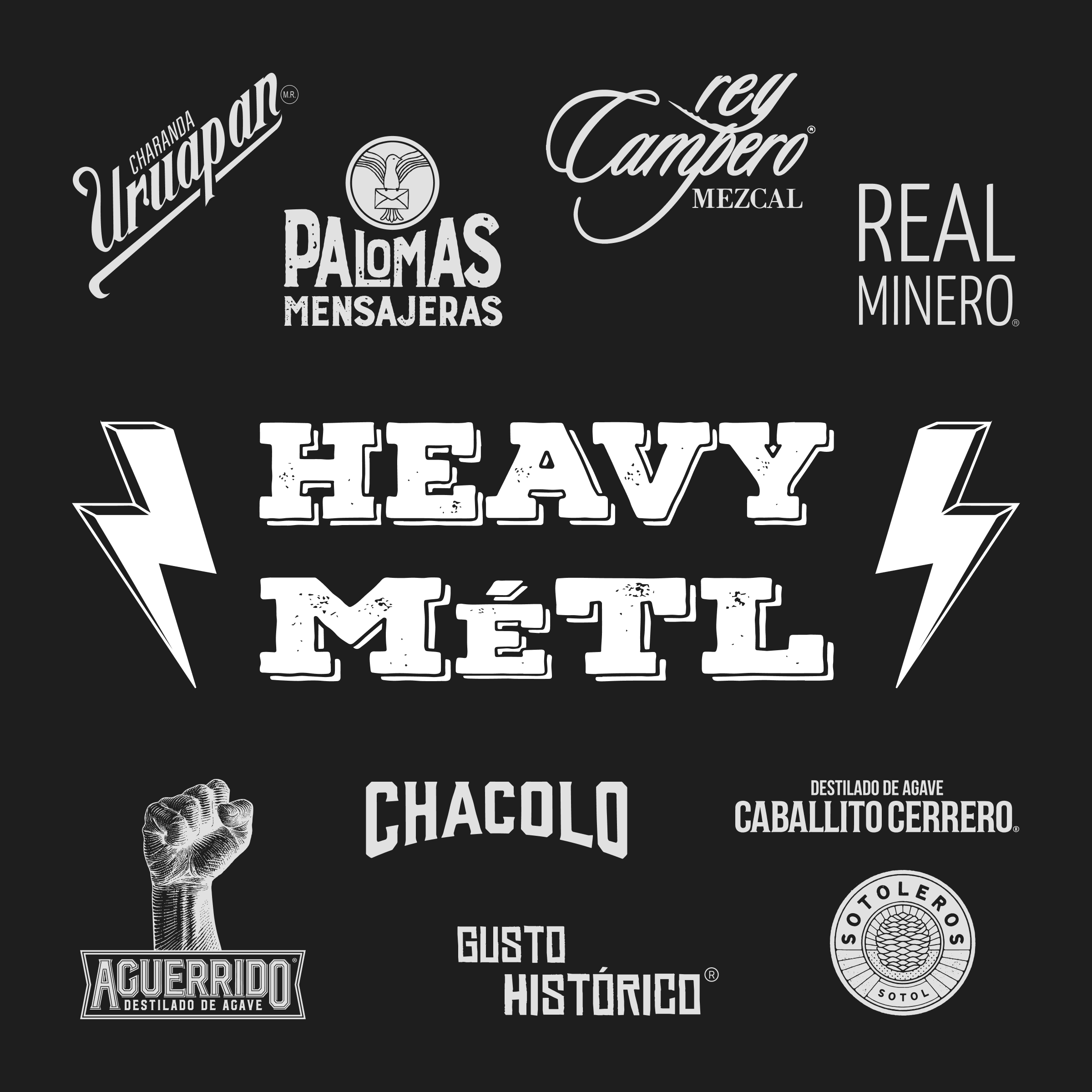
Catador Itinerante
3 years agoThis is fascinating. Thanks for the in-depth article! I have a whisky blog and podcast in Spanish and I also work in a liquor store that carries a great selection of whisky, rum and mezcal. Since the beginning of this year I’ve been organizing mezcal and whisky tastings and got hooked with mezcal after a few Del Maguey and Jolgorio seminars. I decided to write an article about mezcal and that’s how I discover this website. Funny thing is, a week ago I tasted a Kilchoman Mezcal Finish. Sláinte, salud!
Gab
4 years agoGreat piece- I love lagavulin (especially over a tiny bit of vanilla ice cream) and want to get into mezcal. I randomly searched the two together and this article popped up. I thought I was the only one who was thinking of the connection! Any thoughts for a very first mezcal for a lagavulin lover?
JonnyAuthor
4 years agoWelcome to the world of mezcal! I’d recommend starting with either Mezcal Vago Espadin (a bottle that doesn’t say “en Barro,” as you’ll likely relate more to something distilled in copper vs clay), any Mezcal Alipus, or any Mezcal Nuestra Soledad. Depending on where you’re located these may be available. Otherwise they’re definitely available online through sites like Old Town Tequila.
PbRx
4 years agoGreat write-up. I started tasting mezcal a few months ago, when someone gave me a sample, and the comparison to Scotch immediately was obvious. Since then, I have been spending a lot of time and money on mezcal, trying to learn more. It has been exciting but frustrating as well. With Scotch and Bourbon, it is more of a guided tour because you can often get the same batch as what reviewers like T8ke wrote about. Not so much for mezcal, because of the small batch size and I have to buy on line where they usually don’t list batch numbers. I have found that there are variations from batch to batch from the same producer, so it has been an independent study project. At this stage of my journey, it would be nice to have some hand holding to know what I am supposed to look for, but I’ll get there eventually.
JonnyAuthor
4 years agoYou’re right, the size and availability of specific mezcal batches can make it difficult to meet expectations around many bottles. As you go further down your mezcal journey, you’ll find that certain brands and producers have less variation from batch-to-batch. The first that come to mind are Rey Campero, Vago, Real Minero, Nuestra Soledad, and Alipus. Those brands are all pretty consistent across their different producers, so they’re a good place to start if you haven’t tasted them already.
BoulderBrexitRefugee
4 years agoReally interesting article. I’ve been enjoying (mostly Islay) single malts for over a decade, but only this year ventured into mezcal. What’s particularly interesting from my POV is how in my personal tasting notes I have comments about qualities and characteristics that remind me more or less of whisky(!)
JonnyAuthor
4 years agoVery interesting! We’re hearing more and more of that from the Whisky community. Good to see things moving in that direction.
Rorschach
4 years agoVery nice, I am going the other direction, from mezcal to whiskey. It won’t be a long journey cause I like mezcal. It is good to know that mezcal can hold it’s own like this among these full flavor drinks.
Aquilino died a couple of weeks ago. I saw some of his bottles on the shelf at Specs the other day. Might be worth grabbing this label.
Rorschach
4 years agoHey what about that Sierra Norte whiskey from Oaxaca?? Seems like a good place to start.
I have not tried it yet, but I will once I find it. Shows it is available here.
JonnyAuthor
4 years agoThat would have been a good inclusion in this article actually. I’ve heard they’re using various Oaxacan corn varieties that create an interesting tasting experience.
Rorschach
4 years agoI really can’t say about whiskey, but I did start with the clear unoaked whiskey, and have none to recommend! I do think mezcal is the best gateway spirit for wine folks. This is where I came from. Such great parallels between the two. I swerve into tequila every now and then just to remind myself how wonderful mezcal is.
JonnyAuthor
4 years agoYes. It’s very sad what happened to Aquilino. He will not be soon forgotten. Regarding you moving from mezcal into whiskey, are there any specific whiskeys that you’d recommend for people who like mezcal?
Legitimate_Cobbler
4 years agogreat piece!
El Dawg
4 years agoGreat in-depth article – very informative & engaging! Keep em coming!
t8ke
4 years agoKnocking it out of the park here on this one. Great piece! The peat smoked agave parallel is really fascinating to consider.
t8ke
4 years ago@joe
I’d really recommend trying a couple different bottlings. I don’t take too much stock in ‘regions’ because outside of Islay, they all present distilleries that have extremely diverse profiles. That said – here’s 5 I’d try. If you give them a go and let me know what you like best, it’s easy to hone in on your tastes.
– Macallan 12 is a great sherried dram. It’s ubiquitous, not the most expensive, and demonstrates what a good sherry influence can deliver. Other notable similar bottles that are just as good/better but harder to find regionally are Glendronach 12 and Aberlour 12 NCF.
– Laphroaig 10 – raw peat, no sherry influence. pure bourbon barrel + peat
– springbank 10 – less aggressive peat, much more complex and defined structure.
– ben nevis anything – a great look at pure, unpeated, base spirit
– balvenie 12 double cask – good introductory look at what a little sherry finish can do, with competent base spirit
Optimosucio
4 years agoWhat if it’s the vice versa? A Mezcal fanatic that wants to venture in the scotch world? Where to begin?
JonnyAuthor
4 years agoA fair question! Our whisky experiences are somewhat limited based on what our friends have introduced us to. I’m sure someone coming from a whisky background could guide you better than me. But personally, I really dig Islay Scotch. I’ve found that super peaty scotches really ride well on my palate for one reason or another. Laphroaig, Lagavulin and Ardbeg are all big winners for me.